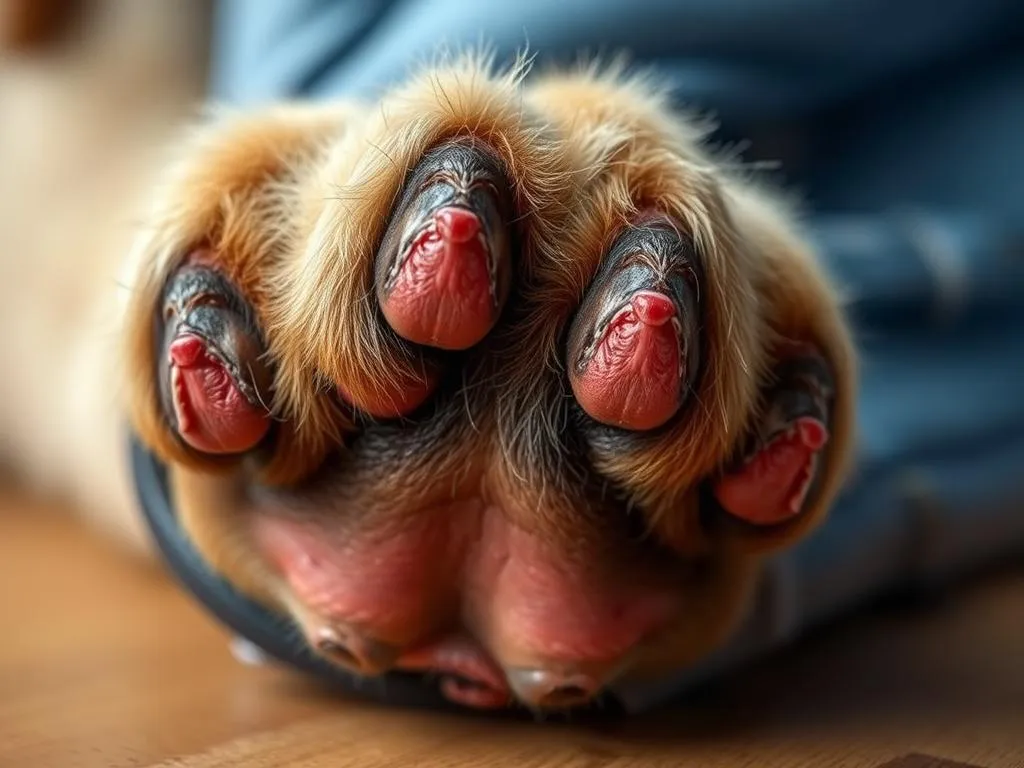
Introduction
Blisters on dog paws are a common concern for pet owners, yet they can often be misunderstood. Blisters are fluid-filled pockets that form on the skin’s surface, usually as a result of friction, burns, or infections. Recognizing these blisters early is crucial, as they can lead to pain and other complications if left untreated.
Understanding the potential causes, symptoms, and treatments for blisters dog paws vet answer is essential for any dog owner. This guide aims to provide comprehensive insights into this issue, emphasizing the importance of consulting with a veterinarian for a proper diagnosis and treatment plan.
Understanding Dog Paw Health
Anatomy of Dog Paws
Dog paw health is vital for their overall well-being. A dog’s paw consists of several components:
- Pads: These are the soft, thickened areas on the bottom of a dog’s feet that provide cushioning and traction.
- Nails: These protect the tips of the toes and help with gripping surfaces.
- Fur: While not directly on the pads, the fur around the paws can provide some protection against environmental elements.
Understanding the anatomy helps in identifying any abnormalities, including blisters.
Common Paw Issues
In addition to blisters, dog paws can suffer from various other issues, such as:
- Cuts and abrasions from rough terrain.
- Infections, which may cause swelling and redness.
- Ingrown nails leading to discomfort.
Recognizing different paw issues is essential for effective treatment.
Causes of Blisters on Dog Paws
Blisters can form on dog paws due to several reasons:
Environmental Factors
- Hot Surfaces: Walking on hot asphalt or sand can cause burns, leading to blisters.
- Cold Weather: Icy conditions can cause frostbite, resulting in blister formation.
Physical Injuries
- Friction: Rough terrain can create friction, especially during vigorous activities like running or hiking.
- Allergic Reactions: Some dogs have sensitivities to certain grasses or chemicals that can irritate their skin, leading to blistering.
Health Conditions
- Skin Infections: Bacterial or fungal infections can cause blisters and require veterinary attention.
- Autoimmune Diseases: Conditions like pemphigus or lupus can manifest in the form of skin lesions and blisters.
Breed-Specific Sensitivities
Certain breeds, such as Greyhounds and Dachshunds, may be more prone to paw issues due to genetic factors affecting their skin and paw health.
Symptoms of Blisters on Dog Paws
Recognizing the symptoms of blisters is crucial for early intervention.
Visual Signs
Blisters typically appear as raised, fluid-filled pockets on the skin. They may be clear or contain pus if infected. It’s essential to differentiate between blisters and other issues like calluses or warts.
Behavioral Signs
Dogs with blistered paws may exhibit behavioral changes, including:
- Limping: Favoring one paw due to discomfort.
- Excessive Licking: Dogs may lick or chew at their blistered paws, which can worsen the condition.
Associated Symptoms
Additional signs that may accompany blisters include:
- Swelling or Redness: Surrounding skin may appear inflamed.
- Discharge: Pus or other fluids may ooze from the blister.
- Changes in Appetite or Energy Levels: Affected dogs may seem lethargic or less interested in food.
Diagnosis of Blisters on Dog Paws
When to Consult a Vet
If you notice any significant changes in your dog’s paws, such as persistent blisters, it’s essential to consult a veterinarian. Signs that warrant immediate attention include:
- Severe swelling or pain.
- Blisters that are leaking or show signs of infection.
- Behavioral changes such as excessive whining or refusal to walk.
Veterinary Examination
During a veterinary visit, you can expect a thorough examination of your dog’s paws. The vet may perform diagnostic tests, including:
- Skin Scrapings: To check for infections or parasites.
- Cultures: To identify bacterial or fungal infections.
Understanding the diagnostic process can help alleviate your concerns and prepare you for the vet visit.
Treatment Options for Blisters on Dog Paws
At-Home Care
If your dog has mild blisters, you can manage them at home by:
- Cleaning the Area: Use mild soap and water to gently clean the blistered area.
- Bandaging: If necessary, bandage the paw to protect it from further injury.
- Protective Booties: Consider using dog booties to prevent your dog from licking the affected area and to protect the paw from environmental factors.
Veterinary Treatments
For more severe cases, a veterinarian may recommend:
- Medications: Antibiotics or antifungals to treat infections.
- Surgical Interventions: In cases where blisters are extensive or recurrent, surgery may be necessary to remove damaged tissue.
Home Remedies and Natural Treatments
In addition to veterinary care, some home remedies may help alleviate symptoms:
- Oatmeal Baths: Soothing oatmeal baths can provide relief for irritated skin.
- Coconut Oil: Applying coconut oil can moisturize and help heal the skin.
- Supplements: Omega fatty acids may support skin health.
Always consult your vet before trying home remedies to ensure they are safe for your dog.
Prevention of Blisters on Dog Paws
Environmental Precautions
To prevent blisters, consider the following tips:
- Avoid Hot Surfaces: Walk your dog during cooler times of the day to avoid hot pavement.
- Hydration: Ensure your dog is well-hydrated, especially during hot weather.
Regular Paw Care
Routine paw care is vital for preventing issues:
- Inspect Paws Regularly: Check for signs of irritation or injury after walks.
- Nail Trimming: Keep nails trimmed to prevent snagging and injury.
Seasonal Considerations
Adjust your dog care routine based on the season:
- Summer: Use booties to protect against hot pavement.
- Winter: Consider paw wax or booties to protect against ice and snow.
Frequently Asked Questions (FAQs)
What Should I Do if My Dog Has a Blister?
If you notice a blister on your dog’s paw, clean the area gently and avoid popping the blister. Monitor your dog for signs of discomfort and consult your vet for further advice.
Are Blisters on Dog Paws Common?
Blisters can occur but are not extremely common. They are often the result of environmental factors or injuries, so keeping an eye on your dog’s paw health is essential.
Can Blisters on Dog Paws Heal on Their Own?
Mild blisters might heal without intervention, but it’s important to monitor them closely. If you see signs of infection or if your dog is in pain, consult your vet.
How Can I Make My Dog More Comfortable?
To provide comfort, ensure your dog has a quiet place to rest, limit activity, and consider using soft bedding. If necessary, consult your vet for pain relief options.
Conclusion
In summary, blisters on dog paws can result from various causes, including environmental factors, injuries, and health conditions. Recognizing the symptoms early and understanding the importance of veterinary care can lead to effective treatment. Be proactive in monitoring your dog’s paw health, as early intervention can prevent more serious issues down the line. Always consult your veterinarian for concerns regarding your dog’s paws, ensuring they remain healthy and happy.









